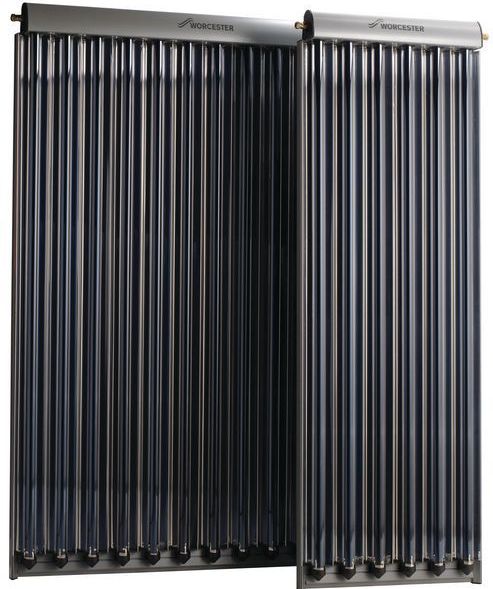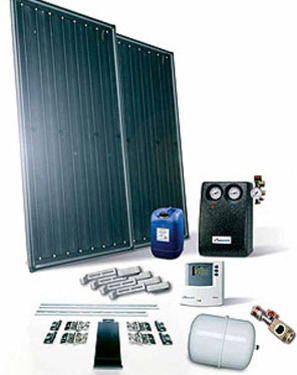SOLAR THERMAL HOT WATER PANELS Free Hot Water Production During the Summer Months Powered by Sunshine
What are Solar Thermal Panels?
A solar thermal panel system is a renewable energy source that harnesses heat from the sun in both direct and diffused sunlight and uses the energy produced to heat the properties domestic hot water cylinder. A standard house with one or two bathrooms would typically require just two panels ideally positioned onto a south facing roof elevation.
Not to be confused with solar PV (Photovoltaic) which use a larger number of panels and are designed to generate electricity, the energy generated by the solar thermal panels solely used for hot water creation.
During summer months, as long as designed and installed correctly, the solar system should provide the bulk, if not all, of the homes hot water without the intervention of any other heat source. In the spring and autumn months, the solar will still heavily contribute with only minor topping up required from the primary heat source. However during the winter months the role reverses, as due to lack of sunshine and shorter daylight hours, the solar will just act as a pre-heat meaning the bulk of the hot water demand will now be supplied by the main heat source.
A solar thermal system can also be used as a pre-heat in properties without a hot water cylinder, where a combination boiler supplies the hot water. This is achieved using specialist controls, however for this page, we concentrate on properties with hot water cylinders only.
Annually a typical solar thermal installation will provide 50 – 70% of the properties hot water demand.
So how does it work?
As already stated, solar thermal panels absorb energy from the sun. The heat radiation generated is absorbed by a glycol fluid mix (water and antifreeze) which runs through pipework within the solar panel.
The heated glycol fluid is pumped through the solar system to the hot water cylinder which stores and distributes the hot water to the property.
The existing hot water cylinder will need to be replaced with one that is solar compatible. The new cylinder will have two internal coils, one for the existing heat source and the other for the solar thermal glycol fluid. The separate coils keep the solar system is totally separate from the rest of the heating / hot water system which apart from the cylinder change, will remain untouched.
The solar system is controlled from a controller generally sited next to the cylinder and most systems will have 2/3 sensors connected, one sensing the temperature of the panels and the other (s) sensing the water temperature (s) in the hot water cylinder.
Solar Thermal Options
There are two main types of solar panels, evacuated tubes and flat plate collectors. Both are similar in installation however, are selected based on roof construction, space availability and orientation. Typically evacuated tubes are slightly more efficient than flat plate collectors although are more fragile meaning they can be easily damaged.
Evacuated Tubes
Each panel consists of a number of glass tubes which are secured together on a mounting frame. Each tube sits into a concave reflective plate which covers the bottom of the tube. This is to allow diffused radiation to be absorbed over from a wider more acute angle. This in effect provides 360Deg absorption. Glycol will flow through each glass tube by means of a U shaped pipe.
The number of tubes required will vary upon demand requirements however typically 12 – 18 tubes are required for most standard installations.
Evacuated tubs are used on older buildings where roof loading weights could be an issue or tiles are old and brittle as they are very lightweight. They are used where shading factors could be an issue or where a south facing orientation is not achievable. Being smaller than a flat plate collector and often supplied in 6 tube arrays, the evacuated tube is handy where roof space is limited.
Siting consideration is required when fitting evacuated tubes as they can be damaged quite easily from falling tree branches or stone penetration as two examples.
Flat Plate Collectors
This is the most common system seen on most properties. The flat plate is much more robust compared to the evacuated tubes.
Toughened safety glass sealed to a heavy duty base houses a full sheet reflective absorber plate which holds a framework of copper pipework used to collect the heat radiation. The safety glass is generally treated with a selective coating which allows better absorption. Every day dust and bird droppings are generally either baked off or washed away with rain fall so panels are easy to maintain.
The flat plate collector is much heavier in weight compared to the evacuated tubes. At circa 40kg each, in some instances a structural survey on the existing roof may be required.
Generally each collector will heat between 120 – 150ltrs of water so typically most homes will have two panels fitted which take up around 4.8mtr2 of roof.
Solar Thermal Applications
Solar thermal panels can be mounted on top of the roof tiles, into the roof (flush with the roof tiles) or can also be mounted onto frame work and sat onto a flat roof. By using various roof mounting bracket options, the solar thermal panels can be installed onto different types of roof constructions, from slate roofs to corrugated roofs.
Solar thermal can also be used to heat swimming pools and on larger projects can be used as a pre heat for water to a commercial calorifier.
Because the solar system is completely detached on a standard heating system, it will work in conjunction with most heat sources, gas, oil, LPG and heatpumps to name a few.
Siting
In order to maximise solar gain it is important the panels are installed ideally facing due south. South west and south east will also work well. If your available roof elevation faces east or west, you may need either a split system with panels on both elevations, or additional panels to maximise the shorter solar gain period if only one elevation is used. North facing elevations should be avoid.
Ideally a clear horizon is ideal however it should be noted that tall trees, neighbouring roofs or other obstacles could cause shading issues which will ultimately affect the solar systems performance.
Solar Safety
As with any mechanism used to heat hot water, safety from scolding is vital and compulsory. All pipework between the panels and cylinder is insulated using high temperature insulation. Pipework is also secured using brass clips and not plastic due to the high temperatures generated.
Evacuated tubes will produce a much higher temperature in the pipework so in most cases a pre cut coil length of stainless steel pre insulated twin pipework is used. As this type of pipework is supplied in coils, there are no plumbing joints between panels to the pumping station, and from the pumping station to the cylinder.
Different cylinder types will have different safety features and although the solar thermal system has its own safety features built in, in the event of total system failure, a thermostatic blending valve is always fitted on the hot pipe supplying water to the taps, normally just above the cylinder outlet. This blending valve is designed to cope with the high solar temperatures and is the ultimate safety feature should all else fail.
Externally the solar panels will be installed off scaffolding which will be erected under the proposed roof elevation. Panels will be lifted onto the roof using a special lifting bag from a winch and pulley system.
So Why Purchase Solar Thermal Panels?
If you are family with a high hot water demand, or if you like the idea of getting free hot water during the warmer months of the year, then solar thermal is the perfect solution.
Currently solar thermal falls within the Governments RHI (Renewable Heat Incentive) grant funding (see grant funding section on useful info button below)
Free Hot Water during Summer Months
Panels work in direct or diffused sunlight
No CO2 emissions when in operation
Easily integrated into existing systems
Very Low Maintenance
Government Financial Incentives
Once Installed
Once you have had your solar thermal installation completed we do not disappear into the sunset.
Air Management Solutions offer a competitively priced maintenance package which covers your annual service (Please contact the office for more details). We will automatically contact you when due, to arrange a suitable time and date to attend.
Our fully certified and qualified team are committed to ensuring all our customers needs are met by offering a highly skilled, professional, efficient and cost effective service tailored to your individual needs. And you can rest assured that all work is fully guaranteed.











